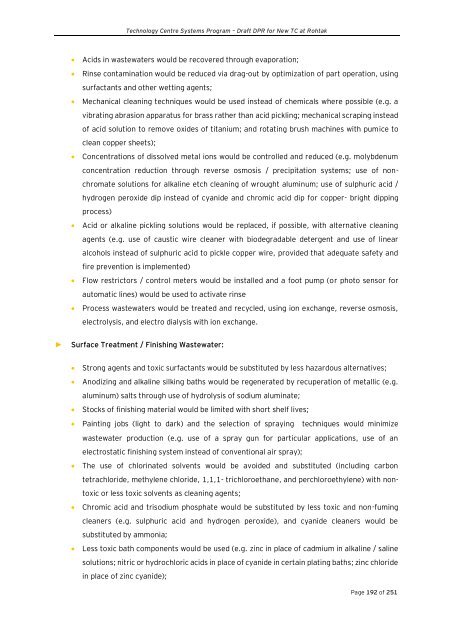Draft Detailed Project Report
Rohtak
Rohtak
Create successful ePaper yourself
Turn your PDF publications into a flip-book with our unique Google optimized e-Paper software.
Technology Centre Systems Program – <strong>Draft</strong> DPR for New TC at Rohtak<br />
Acids in wastewaters would be recovered through evaporation;<br />
Rinse contamination would be reduced via drag-out by optimization of part operation, using<br />
surfactants and other wetting agents;<br />
Mechanical cleaning techniques would be used instead of chemicals where possible (e.g. a<br />
vibrating abrasion apparatus for brass rather than acid pickling; mechanical scraping instead<br />
of acid solution to remove oxides of titanium; and rotating brush machines with pumice to<br />
clean copper sheets);<br />
Concentrations of dissolved metal ions would be controlled and reduced (e.g. molybdenum<br />
concentration reduction through reverse osmosis / precipitation systems; use of nonchromate<br />
solutions for alkaline etch cleaning of wrought aluminum; use of sulphuric acid /<br />
hydrogen peroxide dip instead of cyanide and chromic acid dip for copper- bright dipping<br />
process)<br />
Acid or alkaline pickling solutions would be replaced, if possible, with alternative cleaning<br />
agents (e.g. use of caustic wire cleaner with biodegradable detergent and use of linear<br />
alcohols instead of sulphuric acid to pickle copper wire, provided that adequate safety and<br />
fire prevention is implemented)<br />
Flow restrictors / control meters would be installed and a foot pump (or photo sensor for<br />
automatic lines) would be used to activate rinse<br />
Process wastewaters would be treated and recycled, using ion exchange, reverse osmosis,<br />
electrolysis, and electro dialysis with ion exchange.<br />
►<br />
Surface Treatment / Finishing Wastewater:<br />
Strong agents and toxic surfactants would be substituted by less hazardous alternatives;<br />
Anodizing and alkaline silking baths would be regenerated by recuperation of metallic (e.g.<br />
aluminum) salts through use of hydrolysis of sodium aluminate;<br />
Stocks of finishing material would be limited with short shelf lives;<br />
Painting jobs (light to dark) and the selection of spraying techniques would minimize<br />
wastewater production (e.g. use of a spray gun for particular applications, use of an<br />
electrostatic finishing system instead of conventional air spray);<br />
The use of chlorinated solvents would be avoided and substituted (including carbon<br />
tetrachloride, methylene chloride, 1,1,1- trichloroethane, and perchloroethylene) with nontoxic<br />
or less toxic solvents as cleaning agents;<br />
Chromic acid and trisodium phosphate would be substituted by less toxic and non-fuming<br />
cleaners (e.g. sulphuric acid and hydrogen peroxide), and cyanide cleaners would be<br />
substituted by ammonia;<br />
Less toxic bath components would be used (e.g. zinc in place of cadmium in alkaline / saline<br />
solutions; nitric or hydrochloric acids in place of cyanide in certain plating baths; zinc chloride<br />
in place of zinc cyanide);<br />
Page 192 of 251


